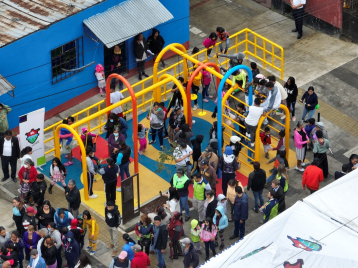Guatemala City, Guatemala
Improving the Quality of Life in Neighborhoods Through Public Space, Resident Participation and Preventive Security
Project Type:
Community Engagement, Equity, Health and Wellbeing, Technology

At a Glance
44% reduction in criminal activity (on average) in 2019 compared to 2016 in six neighborhoods prioritized through the program Prosperous Neighborhood. 12% reduction in crime victims and 26% increase in the perception of security in the Próspero San José La Chácara neighborhood in 2022.
More than 275,000 residents benefitted directly or indirectly from the Prosperous Neighborhood between 2017 to 2023.
Residents of all ages created 1,216 drawings of their ideal neighborhood in the Neighborhood of Your Dreams workshops. These drawings informed the design of public space improvements.
In a 2023 survey, 90% of respondents in the Próspero San José La Chácara neighborhood said that improving public spaces contributes to improving relations between neighbors.
The preventive security and protection of a neighborhood is strengthened when residents feel empowered to improve and control public spaces. This simple but powerful idea is a fundamental premise of Guatemala City’s Prosperous Neighborhood Program, promoted by Mayor Ricardo Quiñónez, which combines data analysis and resident participation to increase safety and improve quality of life in neighborhoods in this growing city. The Prosperous Neighborhood Program, implemented by the Municipality of Guatemala, with the support of the Embassy of the United States of America in Guatemala and the Government of Guatemala, focuses on three main areas:
- Work in the neighborhood to revitalize and improve public spaces that promote social gatherings, recreation, and community events.
- Increasing civic participation of residents, through training, social, cultural, recreational and economic strengthening programs.
- Collaboration between police and the community to improve security, promoting peaceful coexistence and order.

The first step was to identify where to start the program. In 2016, with the support of the Ministry of the Interior, the National Civil Police and other government agencies, Mayor Ricardo Quiñónez’s delegates identified the six municipal areas with the highest crime rates. These six zones comprise 38% of the city’s area and are home to 64% of its population. Subsequently, the program team identified the areas where there was the highest concentration of criminal acts in each area. For the first phase of the program (2017-2019), six neighborhoods with high population concentration adjacent to these areas with higher crime rates were prioritized to make improvements, seeking to strengthen citizen coexistence and improve security with a preventive approach. For the second phase, three priority neighborhoods were added (2020-2022).
The City sought a successful crime prevention model to inform improvements in public spaces. The municipal government team involved residents in priority neighborhoods through exploratory walks, surveys and workshops. For example, the “Neighborhood of Your Dreams” workshops allowed residents of all ages to express their visions for improvements through drawings.
The improvements in public spaces varied depending on the neighborhood, since they respond to the needs that the neighbors expressed about each one. For example, in one of the nine neighborhoods intervened to date, in the area of San José La Chácara and Saravia in Zone 5, more than 15,000 residents have directly benefited, since a new promenade has been implemented that includes a bike lane, exercise machines, trees and improved lighting.
Regarding preventive security infrastructure, a Community Kiosk was installed in the existing park. The strategy to locate these facilities seeks to build them close to squares, parks or public transport stations, integrated into a video surveillance system and constant training for police officers, since they are articulated with existing police stations, stations and substations of the National Civil Police.
The overall results are encouraging: more than 12,000 square meters of public spaces recovered in 9 neighborhoods, including squares, parks, walks and bike paths, directly benefiting more than 119,000 people.
For residents, the benefits of the Prosperous Neighborhood Program included a reduction in crime rates and an increase in perceptions of safety. For example, a survey conducted in 2022 of residents of San José La Chácara and Saravia found a 12% reduction in crime victims, a 26% increase in the perception of safety and an increase of seven hours in the use of public parks.

Looking ahead, the Municipality of Guatemala will continue to expand the program while optimizing its approach based on data and lessons learned. Since 2023, it has expanded the Program to 36 neighborhoods, benefiting 48% of the municipality’s population. The results so far confirm that sustainably improving public safety requires more than simply deploying police resources. When residents can confidently use the public spaces they feel are their own, it produces a deeper sense of community—and a more prosperous and secure Guatemala City.
“The city is our home and the goal is for us to love it. Let’s take care of it, live in it and improve it together.”
“Strengthening coexistence between neighbors and improving security in the neighborhoods are priorities for the Prosperous Neighborhood program. We aim to improve the quality of life and create a city with opportunities for all.”
